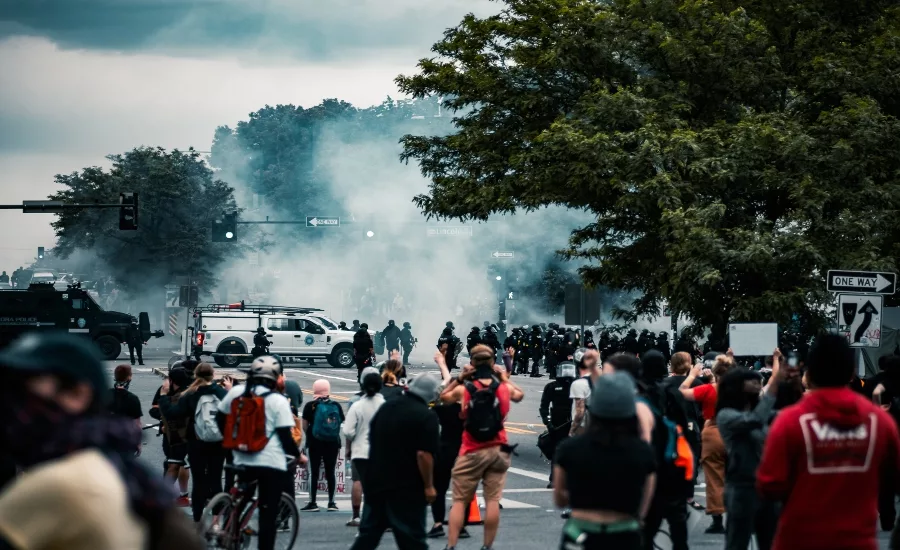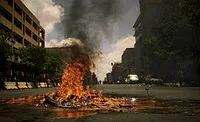Political violence and resilience: A capital markets solution

Political violence can exact a significant toll on communities. The social impact can be as profound as the economic effects, and both dimensions appear to be growing. More recently, there appears to have been an upward shift in political violence and its attendant insured losses, with those events providing an effective proxy for the wider implications in the community resilience context. Specific cases in Turkey, Chile, and the United States speak to a shift in riot and civil disorder risk, along with consequences for risk transfer decision-making. New sources of capital may be able to help communities prepare more effectively for post-event recovery.
A recent but salient trajectory
Historically, riot and civil disorder events have not been significant loss events for the insurance industry, at least compared to other forms of catastrophe. Most riot and civil disorder events have been localized, reducing the potential economic impact, and with them losses for the insurance industry. For large political violence events that have had significant economic consequences, the impact to the global insurance industry was mitigated by a lack of market penetration. Quite simply, insurers haven’t had to worry about riot and civil disorder risk to the same extent that they’ve had to worry about hurricanes, earthquakes, and hailstorms. Over the past five years, though, we’ve seen that starting to change.
Last year’s riots in the United States were unusual for the insurance industry – simply by virtue of being so costly. According to proprietary data from PCS, the team I lead at Verisk, there were only 12 riot and civil disorder catastrophe events from 1950 through 2019. The 1992 riot in Los Angeles was the most expensive for carriers – to the point that it was an outlier – with nearly $800 million in insured losses (not adjusted for inflation). The average loss to the insurance industry from riot and civil disorder catastrophes was less than $50 million, excluding the 1992 event.
PCS has only limited insight into riot and civil disorder insured loss events outside the United States, but it only takes two of them to signal, in retrospect, a change in how such events can affect the global insurance industry. A 2016 political violence catastrophe event in southeastern Turkey resulted in one of the largest industrywide insured losses in the past 20 years (which is when PCS record-keeping began). In 2019, riots in Chile resulted in an industrywide insured loss of nearly $3 billion. Even today, it remains the highest estimated industrywide riot and civil disorder catastrophe loss on record with PCS. And then last year, the George Floyd riot became the first U.S. riot and civil disorder catastrophe event to exceed $1 billion in losses to the insurance industry. In fact, it currently stands at more than double that amount, and the extent of the event is still being ascertained. It was also the first such event to affect more than one state, ultimately, more than 20.
Even though that’s not a large loss compared to many natural catastrophe events, the sharp change in industry dynamic has had an impact. Since 2019, some insurers of large individual property risks have pulled back coverage for riot and civil disorder, and that trend has continued into 2020. Although there’s not been a transformative change in the market, questions about how riot and civil disorder could be covered in the future are arising, and as is usually the case after a significant loss event, many are wondering where capital for future protection could be sourced.
Neither yes nor no … for now
Capacity from the capital markets has become increasingly important to the insurance industry over the past 30 years. Traditionally, insurers turned to reinsurers to help them manage their risk and make the most productive use of their capital. Specialist insurance linked securities (ILS) funds entered the market to provide further capital support and a broader base for sharing the risks associated with extreme events. Today, such funds provide nearly $100 billion in capital for this class of business.
Historically focused on natural catastrophe events, ILS funds have begun to seek new forms of insurance and reinsurance risk. They’ve branched out to marine and energy, terror, cyber, and large single risk losses – although not with anything near the scale of deployment to natural catastrophe risk. Demand for new capital deployment opportunities and a willingness to explore emerging risks would make the ILS community seem like an intuitive fit. However, fund managers have been reluctant to move into the space. To learn why, PCS spoke with 15 ILS funds representing more than 60 percent of the industry by assets under management. And while the ILS market isn’t ready to say “yes” to riot and civil disorder risk, they aren’t saying “no” either.
Only three of the 15 funds mentioned explicit constraints on their ability to provide broad political violence protection (encompassing riot and civil disorder, strikes, and terror). In all three cases, the limitations are only for some of the funds they manage (generally for less than half of assets under management). By PCS’s estimation, the explicit constraints would only apply to a single-digit portion of the capital represented by our respondents (totaling approximately $60 billion).
Although their mandates generally don’t prevent political violence trading (including riot and civil disorder), few ILS funds engage in it. Only four of the 15 responding to PCS are either active in the class of business or have been recently – and one of them only includes it in certain non-catastrophe specialty lines. Two of the four are open to the risk but haven’t found deals they’d be willing to participate in for reasons other than the underlying risk (e.g., pricing). A fifth indicated that they’d review deals that have political violence on a standalone basis but don’t think the pricing could reach sufficient levels. A sixth said they need to see “more sensible structures,” but that “it’s a risk we quite like.” The rest were generally skeptical of standalone political violence (although most have at least some political violence blended into other covers, particularly for natural catastrophes).
Change is coming (maybe)
There are several reasons for the limited take-up of political violence risk by the ILS community. The most common response we’ve received was some form of “rate and structure.” The deal flow they’ve been shown by reinsurance brokers either didn’t carry enough of a premium to make it worth considering a trade, or was structured in such a way as to be otherwise unattractive to the ILS community.
In our conversations, which spanned the first quarter of 2021, we found that these responses really translated roughly to “we aren’t being offered enough premium to make a trade with limited information or loss history for it to be worthwhile.” The next most common factor we heard from the market was that it’s difficult to quantify or otherwise model riot and civil disorder risk. Several specifically indicated the challenges inherent in trying to underwrite the human condition. For many, therefore, the real problems with rate and structure were that the deals didn’t carry enough premium to justify taking on a risk that’s difficult even to understand.
Asking funds about their willingness to buy hedges on riot and civil disorder didn’t yield any breakthroughs. In fact, access to protection was a secondary consideration in decisions not to affirmatively hedge the political violence risk they may assume in natural catastrophe transactions. The incremental risk from riot and civil disorder – all forms of political violence risk, really – to natural catastrophe covers is so small that a hedge would require more than the funds have been paid to assume the risk. Essentially, they’d have to invade margin disproportionately, making such a hedge inefficient.
In the fourth quarter of 2020, there were signs that change could be coming. PCS is aware of two ILS funds that were open to trading riot and civil disorder specifically – as risk buyers or sellers. Trades were unable to be completed due to the fast turnaround that would have been necessary, as the deals were being discussed ahead of the U.S. presidential election. The lack of comparable historical events, short timeframes for analysis and deal completion, and the approvals necessary for unorthodox underlying risks – let alone the negotiations necessary to reach a clearing price – made it pretty unlikely that the market would be able to complete any transactions. However, the conversation has persisted, fueled in particular by civil unrest in the United States this year, and an understanding that the flow of capital from nontraditional sources could be an important component in community resilience.
A U.S. case study with worldwide implications
The ongoing climate of civil unrest in the United States can lead to a focus specifically on that one jurisdiction, but the lessons involved are portable to other parts of the world. And lessons tend to be localized and infrequent, so anything we get takes on disproportionate value. We’ve seen a rapid increase in the scale and frequency of large riot and civil disorder catastrophes, and that’s worth noting. The big question is whether this trajectory can continue, what that means for community resilience around the world, and how the global insurance supply chain – from insurer to ILS fund – can help.
The potential for insured losses – and overall damage to communities – appears to have increased, as evidenced by the significant events of 2019 and 2020, in particular. Risk-bearers may have to adjust their thinking for what could constitute a realistic record-setting industrywide insured loss event. Further, the ongoing climate of civil unrest around the world suggests a clear concern for communities seeking to plan, fund, and implement resilience measures. If the world is moving deeper into a prolonged period of unrest and uncertainty, then identifying ways to finance and transfer risk will only become increasingly important.
Riot and civil disorder may have historically led to smaller insurance industry catastrophe events, but we need to think about how that trajectory is changing. If demand for protection increases alongside losses, then it may be difficult for protection buyers to satisfy their needs without new sources of capital. The historical reluctance shown by the ILS market to assume standalone political violence risk shouldn’t be perceived as a permanent impediment. Structural concerns may exist, but they are addressed most effectively when there are two parties interested in completing a trade. Necessity, as they say, is the mother of invention. The market may not be at that point yet, but we can see it coming. And nothing helps progress along quite like a cleared trade.
Looking for a reprint of this article?
From high-res PDFs to custom plaques, order your copy today!








